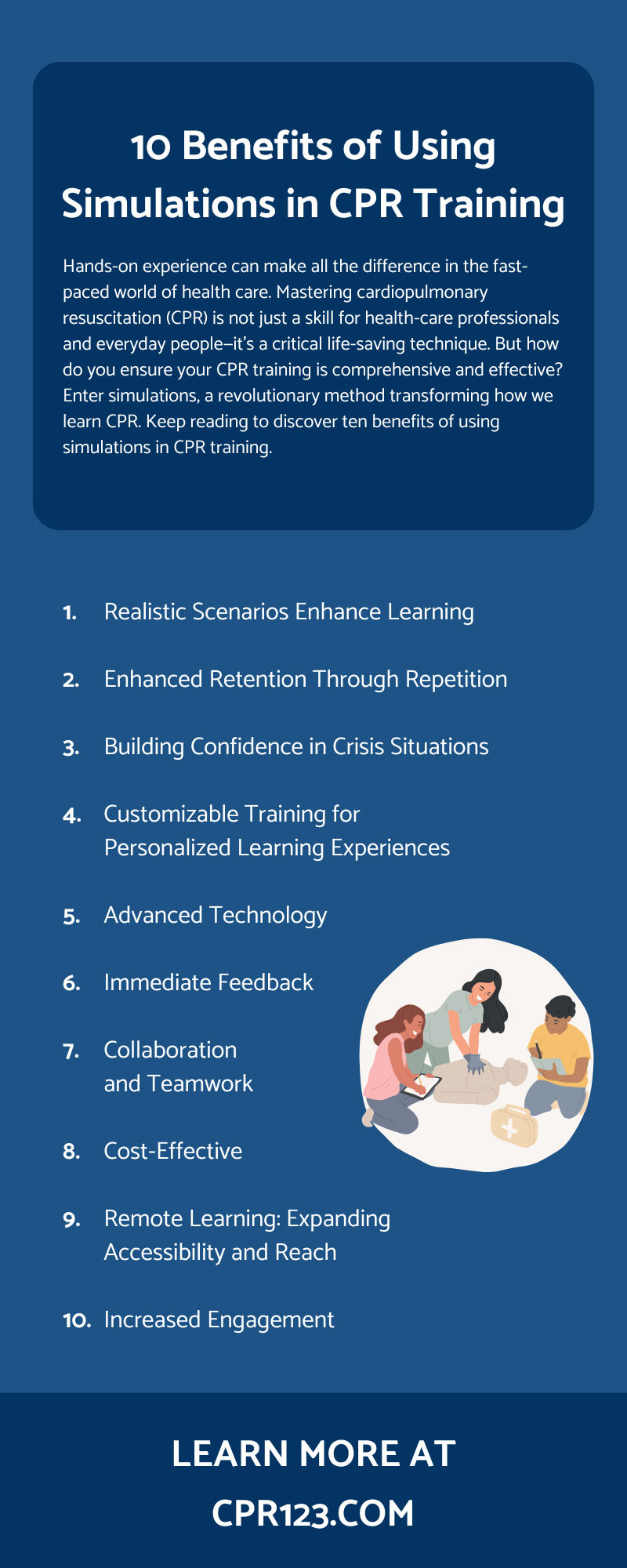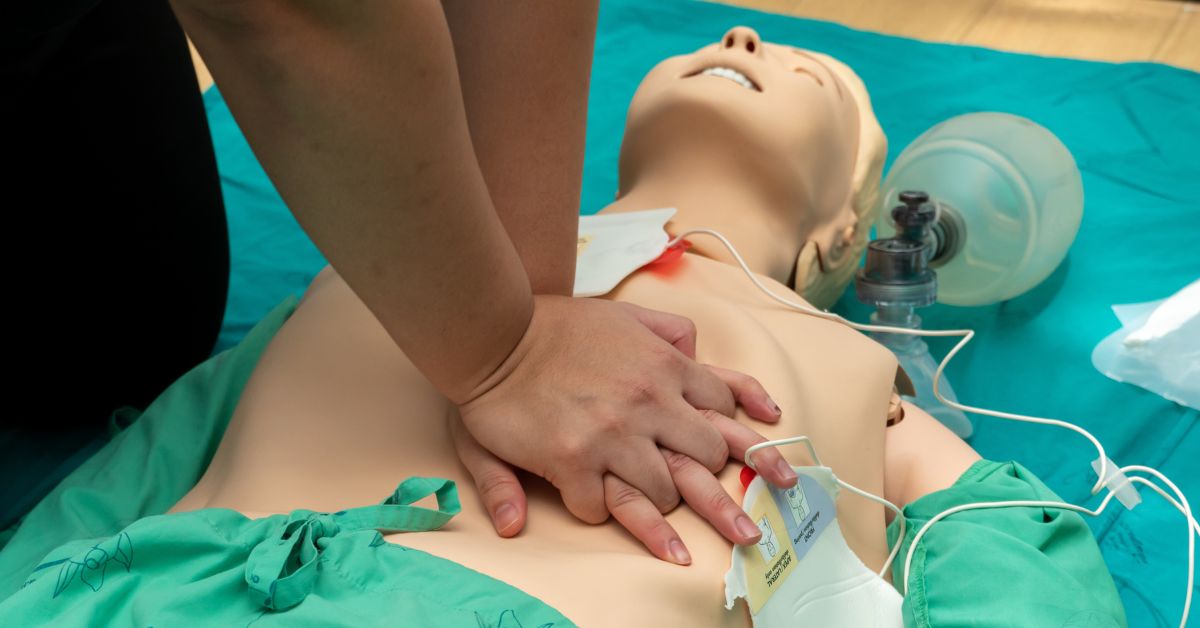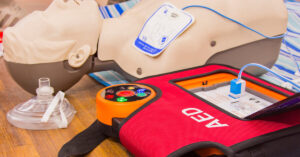Hands-on experience can make all the difference in the fast-paced world of health care. Mastering cardiopulmonary resuscitation (CPR) is not just a skill for health-care professionals and everyday people—it’s a critical life-saving technique. But how do you ensure your CPR training is comprehensive and effective? Enter simulations, a revolutionary method transforming how we learn CPR. Keep reading to discover ten benefits of using simulations in CPR training.
Realistic Scenarios Enhance Learning
Simulations create realistic scenarios that mirror potential emergencies, preparing trainees for any situations they might face. Practicing in these lifelike situations can equip you with the skills to handle high-pressure situations calmly and effectively.
Realistic scenarios bridge the gap between theory and practice and allow trainees to apply what they’ve learned in a safe, controlled setting. This application solidifies knowledge and ensures that trainees can execute these skills under pressure.
Furthermore, simulations provide immediate feedback so participants can adjust their techniques in real-time, enhancing their learning experience and accelerating skill acquisition and refinement.
Enhanced Retention Through Repetition
Repetition is key to mastering any skill, and CPR is no exception. Simulations offer the opportunity to repeat procedures until they become second nature. This repetitive practice ensures that trainees retain crucial information long after the training session ends.
The repetitive nature of simulations supports long-term retention by allowing participants to revisit scenarios multiple times, reinforcing their understanding. This repetition helps cement the techniques necessary for effective CPR.
Simulations also allow for varied practice by creating different scenarios that challenge trainees to adapt their skills to new situations. This adaptability ensures they can handle diverse emergencies with confidence.
[IMAGE A]
Building Confidence in Crisis Situations
A sense of confidence can directly impact the performance and outcomes of a situation when dealing with life-and-death scenarios. Comprehensive simulation training empowers CPR trainees by creating an environment where they can repeatedly practice essential skills without the pressure of real-world repercussions.
Through simulations, trainees work to gain a sense of competence that will translate to real-world emergencies. After practicing CPR in a variety of simulated scenarios, participants will act decisively and effectively when faced with a real crisis, knowing they have successfully navigated similar situations before.
Simulations also build confidence by reducing anxiety, letting trainees familiarize themselves with the procedures, reducing the fear of making mistakes, and boosting their self-assurance and ability to perform under pressure.
Customizable Training for Personalized Learning Experiences
Simulations provide the unique advantage of customizability, enabling trainers to tailor programs to the specific needs and skill levels of their trainees. This personalization ensures participants receive relevant and effective learning experiences, maximizing knowledge retention and skill acquisition.
Trainers using a simulation can adapt the complexity and focus of scenarios based on individual requirements, addressing specific improvement areas and offering targeted support to enhance overall competency. Customizable training modules accommodate various learning paces, ensuring that everyone benefits from training that aligns with their expertise level.
This personalized approach to CPR training fosters an inclusive and adaptable learning environment, paving the way for comprehensive skill development and proficiency in life-saving techniques.
Advanced Technology
Technology is crucial for advancing CPR training through simulations. High-fidelity manikins and advanced software simulate realistic human responses, creating an immersive learning experience. This technology enhances the scenario’s authenticity, improving the training’s overall effectiveness.
Technological advancements provide valuable data so trainers can track participants’ progress and identify areas for improvement, allowing for targeted feedback and personalized training plans.
Virtual reality and augmented reality offer exciting possibilities for CPR simulations, as these technologies create immersive environments that replicate real-world settings. They provide an unparalleled level of realism, enhancing the learning experience even further.
Immediate Feedback
Immediate feedback is a vital component of simulation-based CPR training. Many simulation tools can provide instant feedback on performance, allowing trainees to quickly learn from their mistakes and improve their skills. This rapid feedback loop facilitates immediate correction of errors and reinforces proper techniques, ensuring that trainees can deliver high-quality care.
With the ability to promptly address and rectify mistakes, trainees build more refined skills and a deeper understanding of CPR protocols, which ultimately contributes to better patient outcomes in real-world emergencies.
[IMAGE B]
Collaboration and Teamwork
Simulations foster collaboration and teamwork—essential components of effective CPR. During simulation-based training, trainees work together to solve problems and execute procedures, mirroring real-life emergencies where coordinated efforts are vital.
Collaborative simulations encourage communication among team members. These open lines of communication ensure that all participants understand their roles and responsibilities. This understanding facilitates seamless teamwork during actual emergencies.
Team-based simulations also build camaraderie. Trainees may bond over shared experiences, creating a sense of unity and camaraderie that enhances the cooperation and morale that are essential during high-stress situations.
Cost-Effective
Over time, simulations have proved more cost-effective than traditional training methods. The initial investment in simulation technology and equipment may be significant, but the long-term savings are substantial. Unlike physical resources that need frequent replacement, trainers can reuse and scale simulations for repeated training sessions, reducing material costs.
Moreover, virtual training environments eliminate the necessity of hiring physical spaces or spending on consumable supplies, further lowering expenses. Health-care institutions can maintain high training standards while optimizing their budgets by investing in simulations, making CPR training accessible to more communities without incurring overwhelming costs.
Remote Learning: Expanding Accessibility and Reach
With advancements in technology, CPR training has become more accessible than ever. Remote learning via simulations enables individuals across diverse locations to participate in high-quality training sessions without the need to be physically present. This expansion ensures that geographical barriers no longer hinder the dissemination of essential life-saving skills.
Training providers can offer interactive and engaging simulations that closely mimic in-person experiences by leveraging online platforms and digital tools. Participants can engage with realistic scenarios and receive immediate feedback, just as they would in a traditional setting.
This accessibility broadens the reach of CPR training and accommodates the varied schedules of participants, further facilitating continuous learning and skill development.
Increased Engagement
Simulations turn CPR training into engaging, interactive experiences, boosting motivation and retention of essential skills. Unlike traditional lectures, simulations immerse participants in realistic scenarios, requiring active participation. This hands-on approach fosters a deeper connection with the material, making learning effective and enjoyable.
Participants can maintain focus and their commitment as they navigate challenges, reinforcing their motivation and confidence to apply CPR skills in real-life situations. The dynamic nature of simulations equips trainees with the technical skills and enthusiasm needed for proficient application, driving sustained interest in continuous skill development.
Simulations offer unparalleled advantages in CPR training for trainees of all types. These realistic, hands-on experiences build confidence, enhance retention, and improve teamwork. Simulations prepare trainees to respond effectively in crises by integrating technology and offering flexible, customizable training.
Enroll in a course at an AHA training center for the invaluable opportunity to experience the life-saving benefits of using simulations in CPR training. Your loved ones—and your community—will thank you.








